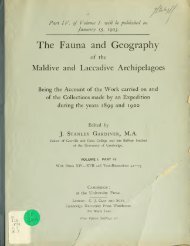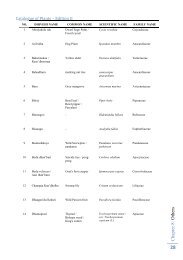640 R. C. PUNNETT.deeply sunk position which it exhibited in the branchial region. Subgenital pits such asWilley found in Spengelia ('99, p. 274) are absent. The gonads form a single row oneither side of the body. Ripe spermatozoa occurred in the specimen from which the sketchof the genital region was taken.As belonging to the family Glandicipitidae there have already been described threegenera, viz. Schizocardiuni, Glandiceps, and Spengelia. It cannot be said with any confidencethat Willeyia bears a closer resemblance to any one of these genera than to another.Features which separate it from all these three are the shortness of the nuchal cornua,the <strong>com</strong>paratively small extent of the branchial portion of the oesophagus as <strong>com</strong>pared withthe digestive, and possibly also the absence of gonads in the branchial region. With respectto other features of generic importance Willeyia resembles now one genus and now another.To which of the above genera it bears most resemblance with respect to the more salientfeatures of its anatomy may be gathered from the appended table, p. 639.Balanoglossus carnosus, Willey, 1899 (PI. XXXVII. fig. 3).Locality, etc. The greater portion of a very large specimen was obtained at Minikoi,at the base of a cyluidrical casting in the sand flat lagoon. Fragments of the same specieswere also found at Hulule in sand under a large Porites mass close to the boulder zone.A coloured sketch was made of the Minikoi specimen by Mr Forster Cooper beforepreservation. This is reproduced on PI. XXXVII. fig. 3, and shews the natural colours ofthe animal. A bright yellow line occurred mid-ventrally which was probably the nerve cord.The dimensions of this large specimen were taken by Mr Gardiner while it was yetalive. I have also taken them on the preserved specimen and the results of both are asfollows : Living PreservedLength of proboscis beyond collar... 9 mm. 3 mm.Breadth „ 5 „ —Length of collar 22 „ 13 „„ „ branchial region — 60 „„ „ genital pleurae — 204 „„ „ animal obtained 440 „ 35.^ „When alive and undamaged the animal probably exceeded 60 cm. in length, and possessedan average diameter of 10—12 mm. The above measurements agree fairly well with thosegiven by Willey ('99, p. 248). There appears to be considerable vai-iation in the relativelength of the branchial region which may be somewhat less than double the collar length,or may be as much as four times as much. The present specimen agrees with the largestof Willey 's specimens, which it rivals in size, in having a relatively long branchial region.In addition to the above fairly <strong>com</strong>plete specimen a number of jelly tubes were foundat the surface in castings similar to that which marked the position of the large worm.These tubes were much distended with sand, and of a transparent straw colour with bi-ightyellow mid-dorsal and mid-ventral lines. The edge of the free (= anal ?) end was markedby brown-black jaigment. Doubtless these tubes are the broken off caudal ends of thisspecies. Like Pt. flava (see p. 646) it may have developed the habit of autotomy.Balanoglossus parvulus, n. sp. (PI. XXXVIIL figs. 15, 18, 22; PI. XXXIX. fig. 24;PI. XLI. figs. 1—4).Locality, etc.Represented only by a fragment <strong>com</strong>prising the anterior end and includingthe proboscis, collar, branchial region, and a portion of the genital region. From Mahlos Atoll.
THE ENTEROPNEUSTA. 641External features. An exceedingly small form. The proboscis is nearly r5mm. inlength and is somewhat longer than the collar (PI. XXXVIII. fig. 18). The branchial regionis about half as long again as the collar. Width of collar and proboscis about 1'5 mm.The width of the branchial region is not quite so great, whilst the genital region is lessthan 1 mm. wide. The anterior border of the collar is rather \vider than the rest of thispart of the animal and is somewhat crinkled. Posteriorly the collar shews a well-markedcircular furrow (PL XXXVIII. fig. 18, t.f.). The genital pleurae are small and are widelyseparated from each other where they join the collar. The mature and swollen gonads in thisspecimen cause the edges of the pleurae to assume a somewhat beaded appearance.Proboscis. The proboscidial coelom is almost entirely filled by connective tissue andmuscle fibres. A delicate layer of longitudinal muscle fibres is found beneath the basementmembrane, but circular fibres are absent. Traces of a dorsal septum are to be found slightlyin front of the pericardial sac. The ventral septum is <strong>com</strong>plete at a level shortly beforethat at which the glomerulus ends ; it carries the ventral glomerulus vessels. The ventralproboscis coelom is packed with, muscle fibres and connective tissue except at its extremeposterior end where the ventral septum is lacking (PI. XXXVIII. fig. 22, v.c). A racemoseorgan is not present.A single median proboscis pore is present, placing the left division of the dorsal probosciscoelom in <strong>com</strong>munication with the exterior (PI. XXXVIII. fig. 22, p.p.). The right moiety ofthe dorsal proboscis coelom ends blindly. Throughout its whole extent the stomochord shewsa well-marked lumen. The lateral diverticula of the stomochord are small (PI. XXXVIII.fig. 22, S.C.). The nuchal skeleton is provided with a deep narrow keel (PI. XLI. fig. 3, sk. 1).The chondroid tissue in this region is exceedingly scanty.Collar. The collar epithelium is very thick (PI. XXXIX. fig. 24, ep.). The glandular zone<strong>com</strong>mences at the level where the cornua of the nuchal skeleton terminate and reaches tothe <strong>com</strong>mencement of the collar funnels. The outer longitudinal muscle layer is well-marked,particularly in the anterior and middle regions of the collar (PI. XXXIX. fig. 24, el.). Theinner longitudinal layer is also strongly developed. No circular muscle fibres are present.The collar coelom is entirely filled with muscle fibres and connective tissue except fora very small space on either side of the dorsal septum. This last-named structure is firstfound immediately behind the first dorsal root in the middle of the collar region. Tracesof a ventral septum exist but in no place is it <strong>com</strong>plete. The collar funnels are of theusual form and open into the first gill pouch.The cornua of the nuchal skeleton extend half-way round the oesophagus. In lengththey are short, being only about i of the total collar length.The collar cord is tubular containing a single axial canal (PI. XXXVIII. fig. 15) surroundingwhich are the ganglion cells. The layer of dorsal ganglion cells (PI. XXXVIII.fig. 15, gcd.) is thin, being best marked in the region where the first and second dor.salroots are given off. Above it is a much attenuated layer of nerve fibrils. The ventralganglion cells {gcv.) are much more numerous and in transverse section are seen as a V-shapedmass shewing a bifurcation at the point of the V. The layer of nerve fibrils surroundingthem is well-developed. Separating the dorsal and ventral ganglion cells on either side isa layer of large oval vacuolated cells—probably gland cells from which the secretion hasbeen ejected or dissolved out. Some deeply staining mucoid substance is to be found inthe medullary canal. Here and there occur ganglion cells rather larger than the rest,
- Page 7 and 8:
The Fauna and Geographyof theMaldiv
- Page 9 and 10:
The Fauna and Geographyof theMaldiv
- Page 11:
CONTENTS OF VOL. II.PAKT II.Reports
- Page 14 and 15:
..590 EDGAR A. SMITH.60at3aso-73a
- Page 16 and 17:
—592 EDGAR A. SMITH.3 SC3dSaitnhe
- Page 18 and 19: ,594 EDGAR A. SMITH.3-a ao5j,Moss3
- Page 20 and 21: .596 EDGAR A. SMITH.3oa o"?!00 >iId
- Page 22 and 23: 598 EDGAR A. SMITH.3isaa'a
- Page 24 and 25: 600 EDGAR A. SMITH.Family ACTAEONID
- Page 26 and 27: 602 EDGAR A. SMITH.23. Conus lividu
- Page 28 and 29: 604 EDGAR A. SMITH,59. Harpa ventri
- Page 30 and 31: 606 EDGAR A. SMITH.Family BUCCINIDA
- Page 32 and 33: 608 EDGAE A. SMITH.below the suture
- Page 34 and 35: 610 EDGAB, A. SMITH.135. Sistrum bi
- Page 36 and 37: 612 EDGAR A. SMITH.173. Cypraea cla
- Page 38 and 39: 614 EDGAR A. SMITH.211. Triforis gr
- Page 40 and 41: 616 EDUAK. A. SMITH.which is a para
- Page 42 and 43: . 270.618 EDGAE A. SMITH.265. Clanc
- Page 44 and 45: 620 EDGAR A. SMITH.the shell being
- Page 46 and 47: 622 EDGAE A. SMITH.slender riblets
- Page 48 and 49: 624 EDGAR A. SMITH.330. Area (Barba
- Page 50 and 51: 626 EDGAR A. SMITH.FamilyPETRICOLID
- Page 52 and 53: 628 EDGAR A. SMITH.9. Chemnitz. Con
- Page 54 and 55: 630 EDGAR A. SMITH.Fig. 22. Natica
- Page 57: Plate XXXVI.mii>>-*"^-^ii,.•^16./
- Page 60 and 61: 632 B. C. PUNNETT.Willeyia hisulcat
- Page 62 and 63: 634 R. C. PUNNETT.No. of Specimen.(
- Page 64 and 65: 636 R. C. PUNNETT.Internal structub
- Page 66 and 67: 638 R. C. PUNNETT.The nuchal skelet
- Page 70 and 71: 642 E. C. PUNNETT,but no giant cell
- Page 72 and 73: 644 R. C. PUNNETT.Ptychodera flava,
- Page 74 and 75: 646 R. C. PUNNETT.(PI. XLVI. fig. 4
- Page 76 and 77: 648 R. C. PUNXETT.The racemose orga
- Page 78 and 79: 650 E. C. PUXXETT.vialdivensis proc
- Page 80 and 81: 652 R. C. PUNNETT.Collar. The muscu
- Page 82 and 83: 654 R. C. PUNNETT.Table 5.Pt. flava
- Page 84 and 85: 656 R. C. PUNNETT.whilst the oesoph
- Page 86 and 87: 658 R. C. PUNNETT.is always complet
- Page 88 and 89: 660 R. C. PUNNETT.Lastly there is a
- Page 90 and 91: 662 R. C. PUNNETT.apparently devoid
- Page 92 and 93: 664 R. C. PUNXETT.— '^^S*-!^^- Me
- Page 94 and 95: 666 R. C. PUNNETT.-Scr.— tu« HJ=
- Page 96 and 97: 668 E. C. PUNNETT.I ha\-e therefore
- Page 98 and 99: 670 K. C. PUNNETT.gonad spells incr
- Page 100 and 101: 672 R. C. PUNNETT.Table 11(continue
- Page 102 and 103: 674 R. C. PUNNETT.Table 13.Pt. flav
- Page 104 and 105: 676 R. C. PUNNETT.nlc.
- Page 106 and 107: 678 R. C. PUNNETT.Pig. 37. Ft. flav
- Page 108 and 109: 680 R. C. PUNNETT.PLATE XLV.Fig. 42
- Page 111: Fa-UTia and Geography Maldives and
- Page 115: 'Fauna and Geography Maldives aiid
- Page 119:
Fauna and Geography, Maldives and L
- Page 123:
Fauna and Geography, Maldives and L
- Page 127:
Fauna and Geography, Maldives and L
- Page 130 and 131:
(582 L. A. BORRADAILE.typical membe
- Page 132 and 133:
684 L. A. BORRADAILE.arrangement is
- Page 134 and 135:
:686 L. A. BORRADAILE.Subfamily Aca
- Page 136 and 137:
688 L- A. BORRADAILE.gaping. The sp
- Page 138 and 139:
:690 L. A. BORRADAILE.26. Lambrus (
- Page 140 and 141:
692 L. A. BORRADAILE.(12) The third
- Page 142 and 143:
694 L. A. BORRADAILE.macrurous grou
- Page 144 and 145:
:696 L. A. BORRADAILE.the whole, ho
- Page 146 and 147:
698 L. A. BORRADAILE.2. 6th alxloni
- Page 149:
Fauna and Geography, Maldives and L
- Page 156 and 157:
7. Lepidoptera ... .;...... 123Volu
- Page 158:
It was supposed that the whole work






